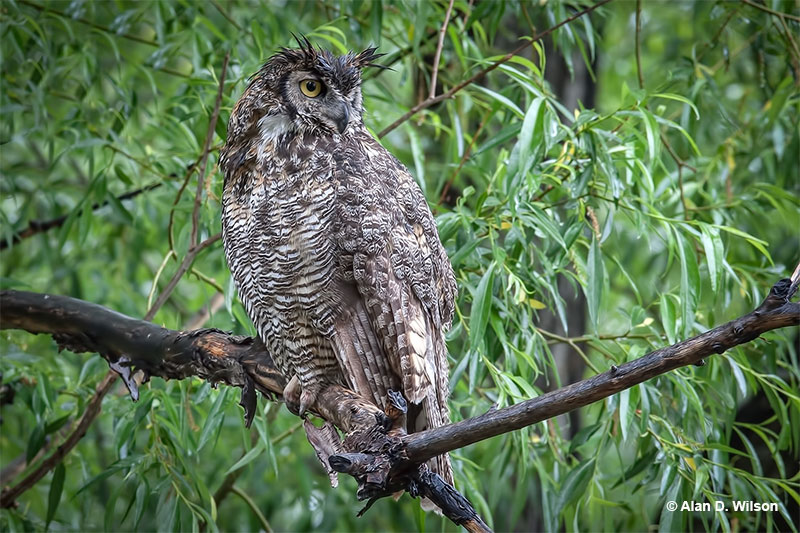The Great Horned Owl, with its distinctive tufted “horns” and piercing yellow eyes, is a master of the night.
It is one of the most adaptable birds ranging across the Americas, capable of hunting a diverse range of prey.
Its exceptional hearing and silent flight make it an efficient hunter, earning it the nickname “Winged Tiger”. So if you hear the haunting hoot of the Great Horned Owl, be prepared to witness one of nature’s greatest hunters.
Identification
Great Horned Owls are large and stocky, have a round head with feathered tufts and a facial disc, and broad and rounded wings. On average they have 15 agreed-upon subspecies that differ in color and size depending on the region.
The coloring of their plumage acts as camouflage and differs from region to region and bird to bird. Typically, their underparts are light with some brown horizontal barring and the upper parts and upper wings are generally a darker version of brown and/or gray with complex darker markings.
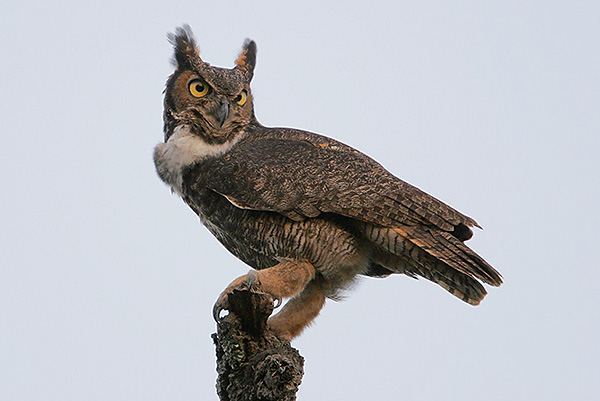
Photographs © Greg Lavaty.
They have dark barring along the sides as well. Their facial disc can be reddish, gray, or brown in color. The white patch on their throat can continue as a streak down the middle of the breast. Its feet are black and feathered and its bill and talons are dark metallic gray.
Great Horned Owl’s size allows it to hunt prey that weighs up to 5.1 pounds. These birds grow 18-24.8 inches long and weigh around 32-88 ounces. Great Horned Owl’s wingspan can measure 39.8-57.1 inches long. On average, females are larger than males.
Great Horned Owl’s call is a low-pitched ho-ho-hoo hoo hoo. The pitch of the call is relative to an owl’s size. The female’s call is higher and rises in pitch at the end.
Most often you can hear them calling after midnight. You can also hear Great Horned Owls produce sounds like growling krroooo-ooo, high-pitched ank, ank, weak and soft erk, erk, and laughing whar, whah, wha-a-a-ah.
Food
Great Horned Owls are carnivores with a diverse diet of over 500 species, ranging from tiny prey weighing just 0.14 ounces to larger prey weighing up to 5.1 pounds.
These skilled hunters perch and search for their next meal, and then dive down to capture it with their talons. On occasion, they’ll even stalk the ground for smaller prey or fly low over the ground to detect it. Despite being nocturnal hunters, they’ve been known to hunt during daylight hours as well.
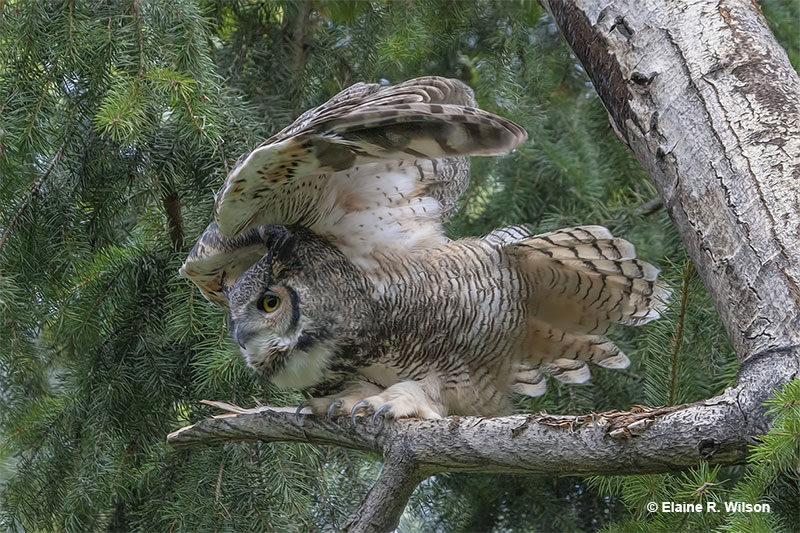
Great Horned Owls have a varied diet that depends on the availability of prey in their environment.
They feed on rabbits, voles, small rodents, insects, fish, amphibians, crustaceans, and reptiles. Their diet varies by region, with lagomorphs and voles being common in late successional areas, small prey like juvenile rabbits and insects in the southwestern U.S., and primarily rodents and insects in fields and deserts. In habitats near water, they are capable of hunting aquatic species.
Overall, almost everything, except for large mammals, can fall prey to these nocturnal hunters, including other birds and raptors.
Nesting and Eggs
Great Horned Owls are monogamous and territorial, chasing away anyone that might threaten their nest or compete with them for prey. They begin nesting very early in the north to give young enough time to learn hunting skills.
Great Horned Owl’s nest is typically 20-60 feet above the ground in trees like cottonwood, beech, pine, or juniper, or in cavities in trees, dead snags, deserted buildings, cliff ledges, or human-made platforms. On occasion, they can also nest on the ground.
They usually adopt a nest built by another species. Because of that, the nests vary in size and appearance but are most often large and bulky and made of sticks. They may add new material to the nest, like strips of bark, feathers, fur, and leaves, or use it as they found it.
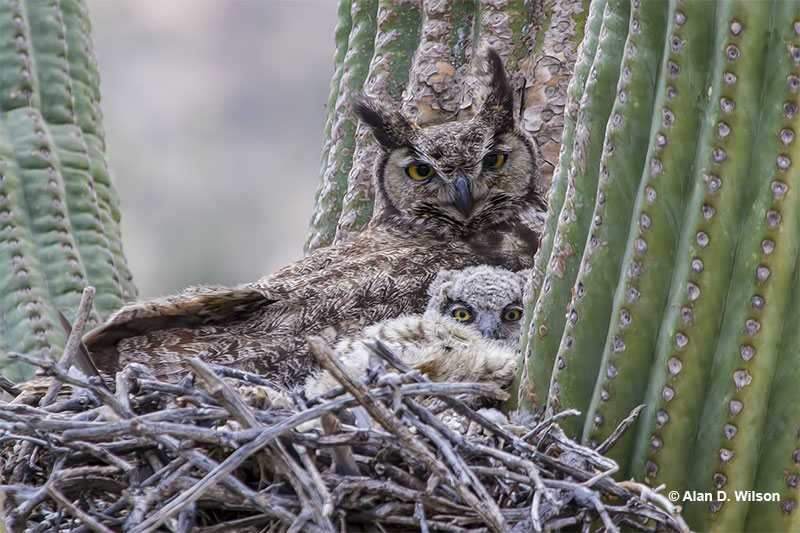
© Alan D. Wilson
This species has one brood per year and the female lays 1-5, on average 2-3 dull white, nearly spherical eggs that have a rough surface.
The eggs are about 2.1-2.2 inches in length and 1.8-1.9 inches in width. The incubation takes 28-37 days and the female and male switch between incubating and hunting duties.
Both of them provide food for the owlets. The offspring may leave the nest and perch on nearby branches at 5 weeks, but they gain their ability to fly at 9-10 weeks. The parents take feed and take care of them for several months.
Juvenile Great Horned Owls are covered in fluffy light-colored down that contrasts with the darker facial disk. Their plumage darkens as they get older with their head being the last to turn from white to a darker shade.
Current Situation
Great Horned Owls are highly adaptable and are native to most of North America and Central and South America. They can be seen from the northern tip of Alaska to the southern tip of Brazil. They’re non-migratory, although individual owls can wander southward in fall and winter.
Great Horned Owl’s habitats are diverse as well. They prefer to inhabit broken areas of woodland and open fields at a variety of elevations from sea level up to 13,000 feet.
You can find them in grasslands, swamps, marshes, deserts, mangroves, and even in rural and urban human settlements. During the breeding season, however, they avoid tundra and unbroken grassland because they need some trees or brush cover for nesting.
Great Horned Owls are listed as a species of low concern in the IUCN Red List and their population has been stable. They’re at the top of the food chain with little threat from other animals. The only known predators are crows and raccoons that sometimes steal and eat their eggs.
Facts
- Great Horned Owl feathers are the second-longest in any owl species. Their short and wide wings allow them to maneuver in a forest and fly very quietly.
- During cold winters in northern areas, Great Horned Owls may store uneaten prey and later come back to it. By that time the prey has probably frozen, and they “incubate” it to thaw it and eat it.
- Great Horned Owls have excellent eyesight and night vision. However, their eyes don’t move in their sockets, so they have to turn their heads to look around. They can turn their head up to more than 180 degrees in either direction.
- The average lifespan of a wild Great Horned Owl is around 13 years. The oldest wild individual lived to be 28 years old whereas the oldest individual in captivity lived to be 50 years old.
- Great Horned Owls do not chew their food, instead opting to swallow their prey whole. This requires their digestive system to process every part of their meal, including bones. The undigested parts, including bones and fur, are compacted into pellets in the gizzard and eventually regurgitated by the owl.
Similar Species
The Great Horned Owl is the largest owl in the United States, so an easy way to tell them apart is their size. However, we have listed two owl species that are quite similar in both size and appearance.
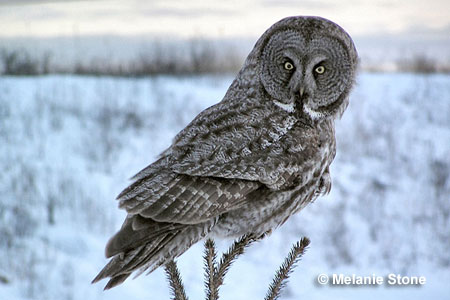
Great Gray Owl
Great Gray Owl – Great Gray Owls look quite similar in coloring and size, but they have a larger head and facial disc.
Their heads look really rounded and pronounced.
They also lack ear tufts.
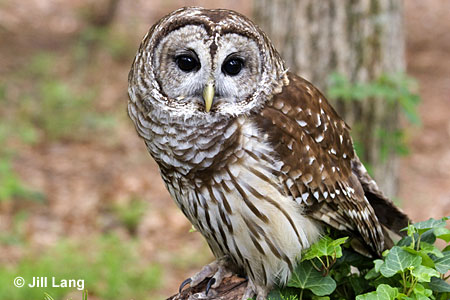
Barred Owl
Barred Owl – Barred Owls are slightly smaller and are a bit whiter on the underside.
The tell-tale sign that you’re looking at a Barred Owl, however, is that they have black eyes instead of yellow ones.
They also have a yellow bill instead of a dark metallic gray one.
Barred Owls have a similar face shape, but they, too, lack the impressive ear tufts.
Related: Owl identification
FAQ
What is special about the Great Horned Owl?
Great Horned Owl is the largest owl species in North America that is very widespread and highly adaptable, having 15 subspecies. They are powerful hunters preying on over 500 species and capable of taking down prey larger than themselves.
How aggressive is the Great Horned Owl?
The Great Horned Owl is known as the most aggressive of all the owl species. It will attack prey larger and heavier than itself, it’s very territorial and will even attack dogs and humans to chase them off.
What does a Great Horned Owl sound like?
Great Horned Owls call with low-pitched and soft stuttering hoots. They can also produce other sounds like screams, growls, coos, shrieks, whistles, and barks.
How long do Great Horned Owls live?
Wild Great Horned Owls typically live up to 13 years old. The oldest known wild individual lived to be 28 years old.
Do Great Horned Owls stay in one area?
Adult Great Horned Owls tend to remain near their breeding area and the breeding territory is held by the same pair from year to year. However, northern subspecies may move southward during the winter.

